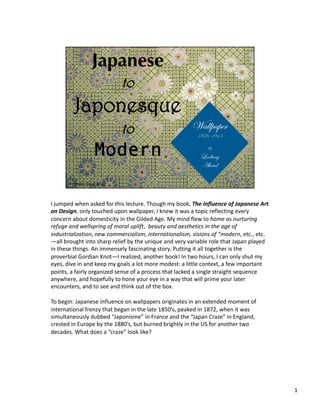
Japanese To Japonesque Talk 3 Notes
- 5. One person—only one—truly understood this phenomenon: the era’s most astute commentator and muse of the Japan Craze whose flamboyant person bespoke the age, The Apostle of Aestheticism: Oscar Wilde. with typical flair he captured the spirit of Japanese art—and what the most imaginative Westerners did with it: No great artist ever sees things as they really are. If he did, he would cease to be an artist… do you really imagine that the Japanese people as they are presented to us in art have any existence? If you do, you have never understood Japanese art at all. They are the deliberate self conscious creation of certain individual artists. If you see a picture by any of the great native painters beside a real Japanese gentleman or lady, you will see there is not the slightest resemblance between them. The actual people of Japan are not unlike the general run of English, that is to say, they are extremely commonplace and have nothing curious or extraordinary about them. In fact, the whole of Japan is a pure invention. There is no such country, there are no such people…the Japanese people are…simply a mode of style, an exquisite fancy of art. And so, if you desire to see a Japanese effect, you will not behave like a tourist and go to Tokyo…you will stay home and steep yourself in the work of certain Japanese artists, and then, when you have absorbed the spirit of their style and caught their imaginative manner of vision, you will go some afternoon and sit in the park or stroll down Piccadilly, and if you cannot see an absolutely Japanese effect there, you will not see it anywhere. 5